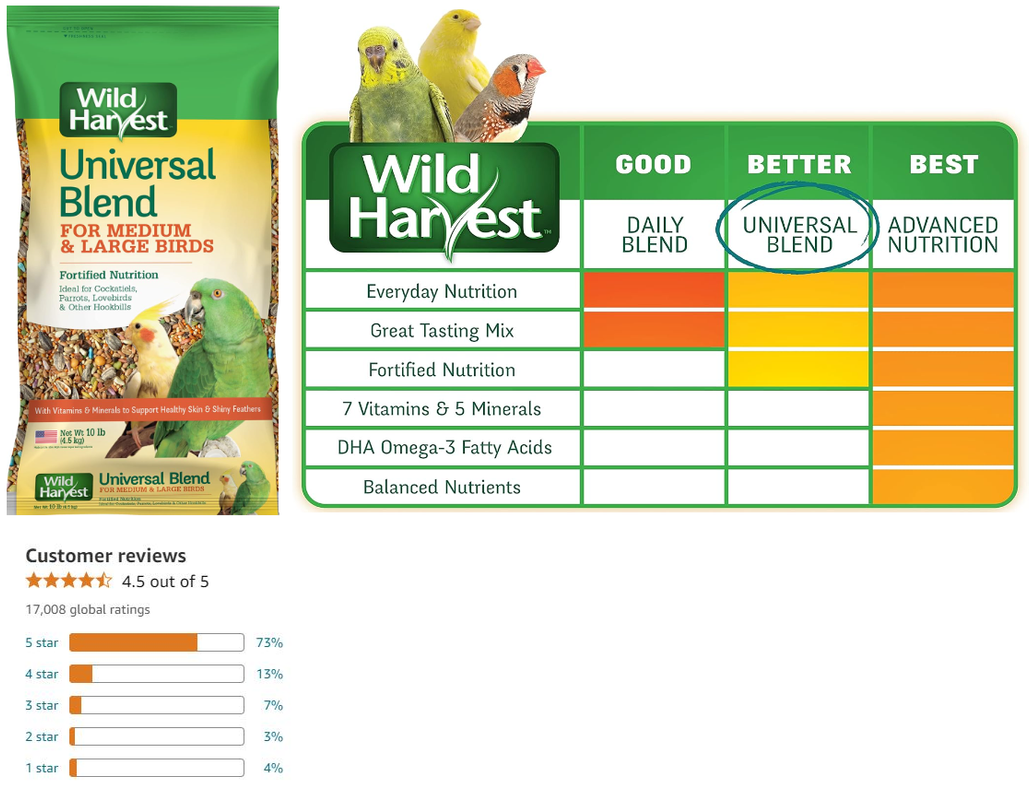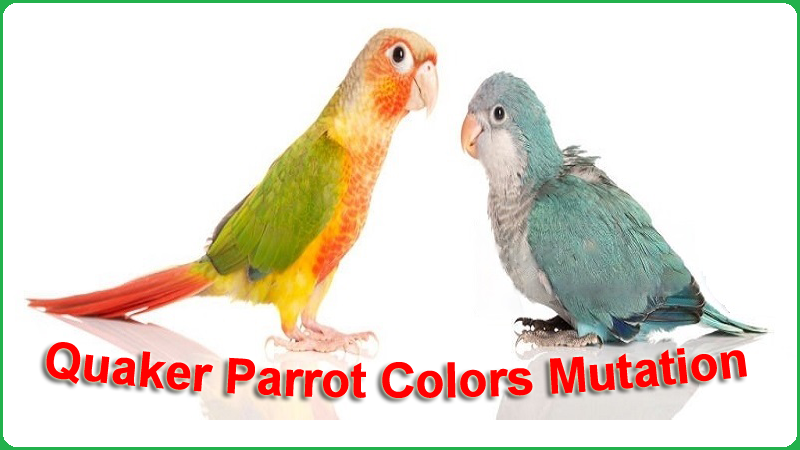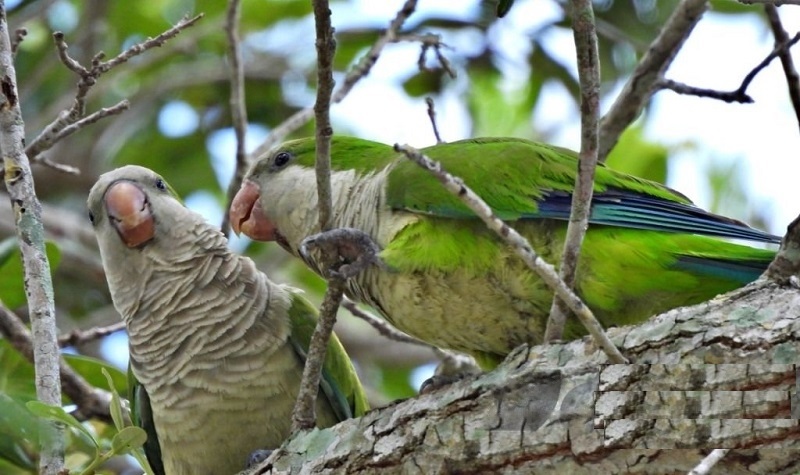Generally, Quaker parrots are found as lime green color with a gray face, neck, and chest. Although, despite of these Quaker parrot colors, other mutations color are also available, including blue and yellow. These different color variations of Quaker parrots make more appealing to pet owners.
Their color variations are existed a range from bright greens to unique pastels. But, now you are wondering about Quaker parrot colors, and how many get mutations they can have?
From this article, we will cover about all the Quaker parrots’ colors, and getting to outline what makes each shade special! So, after reading this post, you will easily understand the full spectrum of these multi-colors birds, and appreciate their stunning diversity.
Natural Colors of Quaker Parrots
These parrots have many natural colors that serve various purposes, such as camouflage and communication. Here, you will get information about natural coloration of Quaker parrots:
Primary Green Plumage
Quaker parrot consists bright green plumage that is most striking feature. This green coloration gets cover maximum part of body (back, wings, and head). This specific green shade has slightly different among individual birds. But, its ranges can vary from a bright, vivid green to a darker, leafier green.
- Camouflage: Their green feathers help to them blend into the foliage of their native habitats in South America that also offer the protection from predators.
- Thermoregulation: The green feathers also allow to regulation in these parrot’s body temperature by offering the insulation.
Gray Face and Chest
They have also another distinctive feature that is the gray coloration on the face and chest. This gray area differs from the green feathers that help to show the parrot’s unique appearance.

- Identification: These Quaker parrot’s color help in species identification that get isolate the Quaker parrots from other green parrots.
- Social Interaction: This gray colors may are also helpful in social interactions among Quaker parrots. These color markings may be used to get recognize individuals.
Blue Flight Feathers
Quaker parrots also get the blue feathers on their wings, but especially they are noticeable when the parrots are flying. These blue feathers get less prominent as compared to green and gray, but they may add an additional layer of color diversity.
- Flight Dynamics: Often, blue flight feathers have the robustness, and they structurally adapted for flying perfectly.
- Aesthetic Appeal: This blue color appends a splash of color that increases the overall beauty of the bird. So, it helps to make appealing to parrots watchers and pet owners.
Tail Feathers
The tail feathers of Quaker parrots also have a mixture of green and blue colors that supporting to their colorful appearance.
- Balance and Maneuverability: The tail feathers allow to balance and maneuverability, whey they are flying.
- Display: Tail feathers also exhibit to other birds their behaviors, especially when they want to mate rituals.
Genetic Color Mutations in Quaker Parrots
Genetic color mutations in Quaker parrot (Monk Parakeets) produce a variety of unique and beautiful plumage colors. These mutations can do naturally or through selective breeding. Here are some common genetic color mutations found in Quaker parrots:
Also Read: How Long Do African Grey Parrots Live? African Grey Lifespan
Blue: A common mutation where the parrot’s green feathers are replaced with a bright blue.
Pallid: This mutation results in a lighter, more diluted version of the original color, giving a softer, pastel appearance.
Turquoise: A blend of blue and green, giving the parrot a turquoise color.
Cinnamon: The green feathers are replaced with a light brown or cinnamon color.
Opaline: This mutation intensifies the parrot’s existing colors that making them more vivid, and often altering the pattern of color distribution.
Lutino: The parrot’s feathers are yellow, and it has red eyes, similar to albino but with yellow pigmentation.
Albino: The parrot has completely white feathers and red eyes due to a lack of melanin.
Pied: This mutation causes irregular patches of color, often white or yellow, mixed with the base color.
Gray-green: The green feathers have a grayish tint, giving the parrot a more subdued appearance.
Dilute: A general lightening of all feather colors, making them appear washed out.
Dark-Eyed Clear: The parrot has entirely white or yellow feathers with dark eyes.
Creamino: A combination of cream and yellow shades, creating a soft, pastel appearance.
Fallow: This mutation causes a reduction in melanin, resulting in lighter feathers and often red eyes.
Violet: A rare mutation where the feathers have a violet tint.
Yellowface: The face and sometimes parts of the body are yellow, while the rest of the plumage remains the original color.
Pastel: A softer, more muted version of the base color, appearing as if the colors have been mixed with white.
Emerald: A deep, rich green mutation.
Silver: The green feathers are replaced with a silver or gray color.
Mint: A pale greenish-blue mutation, lighter than turquoise.
Bronze Fallow: A combination of cinnamon and fallow, resulting in a bronze or light brown color with red eyes.
Factors Influencing Feather Color
There are many significant factors that can be influenced on the feather color in Quaker parrots. Here, you will look each of these factors in detail:
1) Genetics
Genetics is the primary determinant of feather color in Quaker parrots. The natural green coloration and various color mutations are the all results of genetic inheritance.
Also Read: Do Cockatiels Have Ears? Their Unique Hearing
Inheritance Patterns: Specific genes control the production and distribution of pigments in feathers. Mutations in these genes can lead to different color morphs.
Breeding: Development of various color mutations get by selective breeding by aviculturists. Breeders pair birds with desired traits to produce offspring with specific colorations.
2) Diet
Diet plays a vital role in maintaining the vibrancy and health of Quaker parrot’s feathers. Nutritional deficiencies or imbalances can lead to dull, brittle, or discolored feathers.
Vitamins and Minerals: They need some essential nutrients for feather health. This includes, vitamins A, D, and E, as well as minerals like calcium and zinc. A deficiency in these can lead to poor feather quality.
Carotenoids: These pigments, found in fruits and vegetables that contribute to the bright colors in feathers. Birds need to consume carotenoid-rich foods to maintain vibrant feather coloration.
Protein: Adequate protein is necessary for feather growth and repair. Feathers are composed mainly of keratin, a protein, so a protein-rich diet is essential.
3) Health
Overall health significantly affects feather color and condition. Illness, stress, and parasites can all impact feather quality.
Disease: Infections, both bacterial and viral, can lead to feather loss or discoloration. For example, Psittacine Beak and Feather Disease (PBFD) can cause abnormal feather development.
Parasites: External parasites like mites and lice can damage feathers. It may lead to loss of color and structural integrity.
Stress: Chronic stress can result in stress bars that are lines across the feathers. It shows the indicate periods of poor health or nutritional deficiencies.
4) Environmental Conditions
The environment in which a Quaker parrot lives can influence feather color and condition.
Lighting: Proper lighting, especially UV light, is essential for the synthesis of vitamin D3. It is also crucial for calcium metabolism and overall feather health.
Cleanliness: A clean living environment helps prevent feather-damaging conditions. Dust, mold, and poor hygiene can lead to skin and feather issues.
Humidity: Appropriate humidity levels are important for maintaining feather quality. Too low humidity can lead to dry, brittle feathers.
5) Molting
Molting is the natural process of feather shedding and regrowth. So, it can temporarily affect a parrot’s appearance.
Seasonal Molting: Quaker parrots typically molt once or twice a year. During molting, old feathers are replaced with new ones that may appear brighter and healthier.
Stress Molting: Stress or changes in the environment can trigger molting outside the normal cycle. It may potentially lead to uneven feather replacement and temporary dullness.
6) Age
As Quaker parrots age, their feather coloration and quality can change.
Juvenile Feathers: Young birds often have duller, less vibrant feathers. As they mature, their feathers usually become brighter and more vivid.
Aging: Older birds may get experience changes in feather quality and color. This change may due to metabolic changes, nutritional needs, and overall health.
Breeding and Color Variations
Color variations in Quaker parrots, breeding play a massive role in the development and perpetuation. In the selective breeding, breeders can make a pair of birds with specific color traits to produce offspring with desired coloration.
Also Read: Scarlet Macaw Lifespan: Facts & Care Tips for Longevity
So, they choose parent birds at the based on their genetic background and visible traits. Here, you will concise look at how breeding influences these variations:
Common Color Variations
- Natural Green: The standard color, providing camouflage in the wild.
- Blue: A result of a recessive mutation that replaces green feathers with shades of blue.
- Lutino: Characterized by bright yellow feathers and red eyes that resulting from a genetic mutation affecting pigmentation.
- Albino: Completely white feathers with red or pink eyes, due to a lack of all pigments.
- Cinnamon: Features lighter, brownish-green feathers, giving a warmer tone.
- Pallid: Displays a diluted, pastel-like green.
- Pied: Shows patches of green, yellow, or white, creating a mottled appearance.
- Fallow: Light yellow-brown or tan coloration with red eyes.
- Turquoise: Greenish-blue feathers, distinct from the solid blue mutation.
- Opaline: Vibrant colors with unique markings, affecting distribution and intensity.
Genetic Principles
Dominant and Recessive Genes: Color mutations can be dominant or recessive. Dominant traits require only one parent to pass the gene, but recessive traits require both parents to carry the gene.
Heterozygous and Homozygous: Birds can be heterozygous (carrying one gene for a trait) or homozygous (carrying two genes for a trait), affecting the likelihood of passing on specific colors.
Care and Maintenance to Quaker Parrots Colors
You should provide essential balanced diet and proper care to keep vibrant colors of your Quaker parrot. Here are some key tips:
1) Diet
Feed Quaker parrot nutrient-rich diet that includes fruits, vegetables, and pellets.
Avoid high-fat foods like seeds and nuts. Quakers may be prone to fatty liver disease if they get become overweight.
Never feed avocados, chocolate, caffeine, or alcohol, as these can be toxic to parrots.
2) Sunlight Exposure
You have to give sunny spot to perch for your Quaker parrot, including a windowsill and bird aviary.
Sunlight aids to stimulate the production of melanin. So, it is the most pigment responsible for feather color.
3) Cleanliness
Keep your Quaker parrot’s environment clean and well-ventilated. Cleanness prevents the build-up of bacteria and other health issues.
Always, keep away uneaten food daily to your parrots. Should wash and dry food and water dishes daily.
Provide the proper cleanness to cage and quick clean-up daily. You should be giving thorough cleaning weekly, and scrubbing down the bars and replacing the newspaper liner.
4) Grooming
Provide bath water at least once a week, as Quakers love to bathe. This helps maintain healthy skin and feathers.
You may occasionally mist the bird with a grooming spray such as Feather Glo.
Keep the bird’s wings clipped and nails trimmed to prevent injury.
5) Toys and Stimulation
Provide your Quaker parrot with a variety of toys to keep it entertained and mentally stimulated.
Rotate toys often to prevent boredom.
Teach your parrot tricks and commands to engage its intelligence
FAQs (Frequently Asked Questions)
What Are The Most Common Color Mutations in Quaker Parrots?
There are some most common color mutations in Quaker parrots include:
- Blue
- Pallid (Pastel)
- Turquoise
- Cinnamon
- Lutino
- Albino
- Pied
- Opaline
What Causes Color Mutations in Quaker Parrots?
In Quaker parrots, color mutations can occur by genetic variations. These mutations can be autosomal recessive, sex-linked recessive, and combinations of different genetic factors.
How Can I Tell If My Quaker Parrot Is A Specific Mutation?
You can identify the specific mutations often with observing the plumage color and patterns. For get precise identification, you can take consultation a breeder or avian geneticist.
Do Color Mutations Affect Health or Behavior of Quaker Parrots?
Most of color mutations don’t affect the health or behavior of Quaker parrots. However, certain mutations like albino
What Is the Rarest Quaker Parrot Color?
The rarest Quaker parrot color is the dark blue and cobalt mutation. It is a single factor mutation that varies in color between concrete grey and dark purple. This mutation is quite rare and more expensive due to get difficulty in breeding all chicks with a dark chromosome.
What Is The Most Common Quaker Parrot Color?
The most common Quaker parrot color is green that is the wild-type or normal coloration. The green coloration is characterized by a vivid green on the head, wings, and back, with a gray breast, cheeks, and throat
Can Quaker Parrots Change Color?
Quaker parrots do not naturally change color over time. Their color remains consistent after their initial molting phase. If, some changes occur in feather color, then it indicates health issues, dietary deficiencies, or environmental factors.
Verdict Up
As resulting of this article, Quaker parrots display a wide range of color’s diversity, due to various genetic mutations. They have over 20 recognized variations like as blue, turquoise, cinnamon, and the rare violet. However, their most common color is the wild-type green.
If this article is fruitful you, then please share it along with your friends, family members, pet lovers or relatives over social media platforms like as Facebook, Instagram, Linked In, Twitter, and more.
Also Read: How Long Do Macaws Live? Macaws Lifespan in Wild & Captivity
Do you have any experience, tips, tricks, or query regarding this issue? You can drop a comment!
Happy Learning!!







